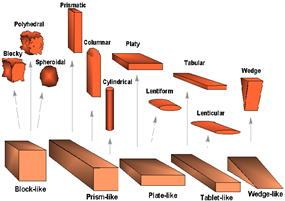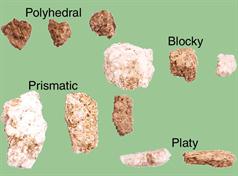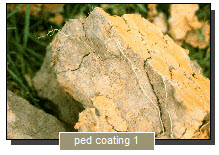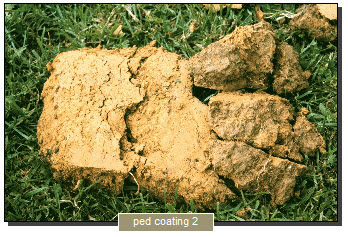Shape Names:
The peds are described using names based on their shape and arrangement in the soil.
The different names for soil peds are based on several basic shapes. (refer examples of types of soil ped)
Spaces between and within aggregates:
The spaces within the soil material are described according to their shape, for example:
Pore:
A void with oval, circular or stellate cross-section.
Tubular Void:
Cylindrical and elongated void.
Vesicular Void:
Spherical or elliptical void.
Channel:
Tubular void of biological origin less than 20 mm in diameter.
Fissure:
A crack or parting with a width much smaller than its length or depth.
 |
|
Peds Diagram of Shapes
|
|
 |
|
Examples of Soil Ped Types
|
|
The different names for soil peds are based on several basic shapes.
Surface Features: Kinds of Surface Features
Kinds of Surface Features:
Peds or gravel may have a distinctive surface e.g. because of being coated with clay or organic material.
The following terms can be used to describe the type of surface occurring on a feature in the soil and are commonly used when describing ped surfaces.
Carbonate Coats:
Mainly calcium carbonate. They may be coats of powdery material or concentrations of larger crystals.
Clay Coats (argillans):
Appear to have more clay than the soil matrix. They are often different in colour from the adjacent matrix and are usually recognisable in sandy or loamy soils, but are difficult to recognise in clayey soils, where they are often indistinguishable from pressure surfaces. (see ped coating 2)
Fracture Faces:
Generally rough-surfaced matt faces on soil materials that do not have the attributes of pressure faces, slickensides or coatings.
Organic coats:
Surface features that have a moist value of 4 or less and are rich in organic matter compared to the interior of the solid. (see ped coating 1)
Pressure faces:
Smooth planar faces on a ped or soil fragment that are not coatings or slickensides.
Sand or Silt Coats:
Sand or silt concentrated at the surfaces; they may be residual
skeletans):concentrations resulting from clay removal, or sand and/or silt may have been moved in from horizons above.
Sesquioxide Coats:
(including sesquans, mangans, and ferrands):
Films of sesquioxides on interfaces or impregnating interfaces.
They vary in colour depending on the composition and degree of oxidation and hydration. They are difficult to identify chemically, and the different kinds cannot normally be distinguished in the field. Ferri-manganiferous coats, however, are normally very dark brown or black and effervesce vigorously with hydrogen peroxide.
Slickensides:
Smooth faces with linear grooves, generally caused by expansion and relative lateral movement of adjoining peds on wetting.


Continuity:
The continuity of a surface feature is estimated for individual surfaces eg, ped faces or gravel surfaces.
Patchy:Less than 25% of surface features are connected with each other.
Discontinuous:25% to 75% of the surface features are connected with each other.
Continuous:More than 75% of the surface features are connected with each other.